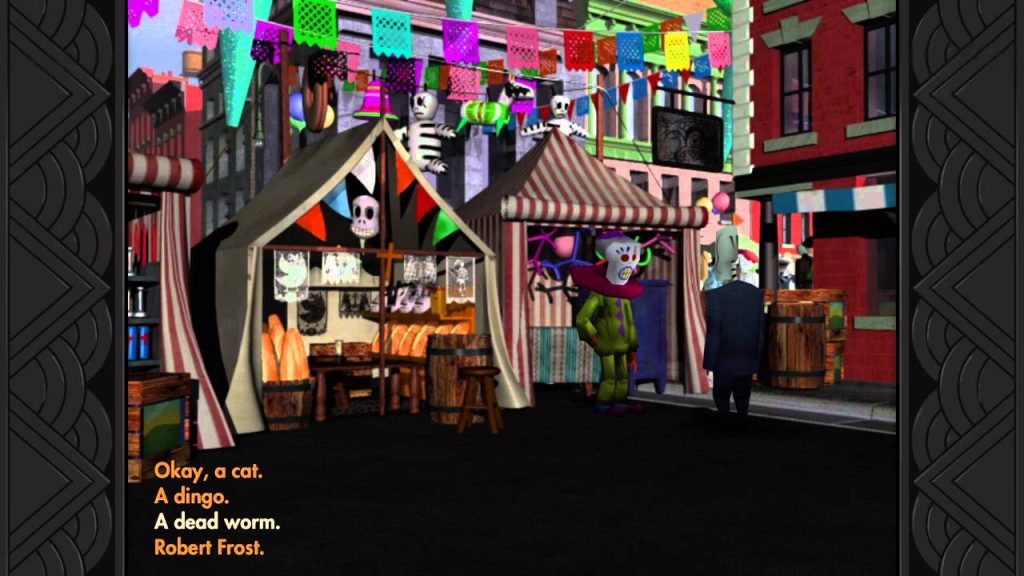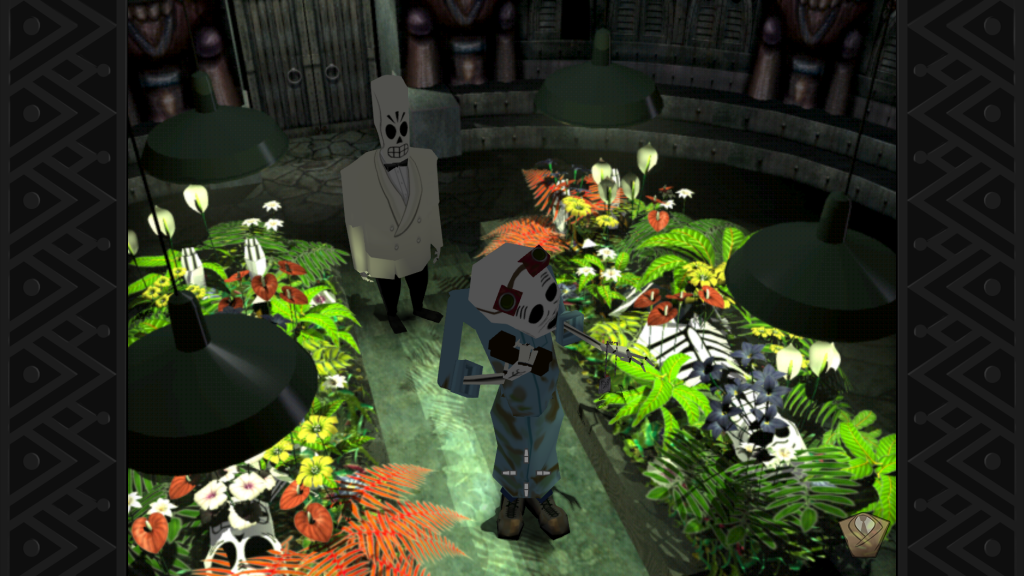Every year, it has been my tradition to play through Grim Fandango on Día de los Muertos. It seems odd that one could build an entire game around a Mexican holiday that’s rather obscure in the rest of the world. Or rather was back when the game was released in 1998, some 20 years before Coco. Yet somehow LucasArts’ adventure division managed to pull it off. Not only pull it off, but create something that’s still considered one of the greatest games of all time.
Día de los Muertos is Mexico’s unique celebration of All Souls Day, an important feast in the Catholic calendar that venerates the dearly departed. It is believed that the souls of the dead return to the land of the living on this day to visit their family. During the celebrations, people tend to the graves of loved ones, and create alters with effigies of the dead called calacas. These skeletal figures are what would inspire Tim Schafer to create his magnum opus.
As such, Grim stands as a love letter to this unique cultural tradition. Yet it also throws it in the blender with Aztec mythology and 1940’s Film Noire to produce something truly wonderful.
The game takes place in Mictlān, the Aztec underworld. According to myth, the dead are required to take a four year journey of the soul, fraught with trials and perils, before they are allowed to entre the land of eternal rest in realm’s 9th level.

You play as Manuel “Manny” Calavara, a grim reaper tasked with harvesting the souls of the dead and bringing them to Mictlān. Except, he’s less an angel of death and more a travel agent. In this world, those who have led a life of virtue, and have money, can buy packages to make the trip a little easier. The most illustrious of which is the Number 9, a luxurious express train that whisks only the most saintly of souls to the 9th Underworld in 4 minutes instead of 4 years.
Manny needs to sell those tickets to pay off his debts to the gods and finally make the journey himself. There’s just one small problem. He used to be the top salesman for the Department of Death with only the best customers. Now all he’s getting is deadbeats and mean midgets. Meanwhile rival Domino is suddenly snatching up all the premium clients, while his boss is crawling up his skull to sell more “Double N” tickets. What Manny needs is a saint. A rich, dead saint.
Like any good Noire story, things are never quite as they appear on the surface. Buried underneath the DoD is a tangled web of crime and corruption that threatens to tear apart the vary fabric of the Land of the Dead. Manny soon finds himself caught up with an underground resistance group, and a big orange demon with a passion for fast cars, as he sets out on a dangerous journey to find the saintly dame that got away.
It’s hard not to notice the huge amount of influence movies like Chinatown, North By Northwest, The Maltese Falcon, Casablanca, and On the Waterfront had on the making of this game. This is probably one of the best homages we’ve seen of the hard boiled genre, film or otherwise. Yet it also came at a time of great transition for the video game medium.
Grim Fandango was the first LucasArts adventure game that would move into the realm of 3D. It was certainly impressive for the time, though certain elements of Grim really do show their age. Most notorious are its tank controls, which seemed to be particularly popular in adventure games during this era. Resident Evil is probably the best known. You have to keep in mind that the idea of analogue movement wasn’t quite so defined yet, and point-and-click was thought of as a bit old fashioned. Yet analogue controllers were far from ubiquitous on the PC. I remember first playing this Grim with a flight stick. It was janky and awkward then, made all the worse by the fact that I’d broken my left arm in a biking accident that summer. So trying to work the keyboard to use the run button was not fun.
Most of the 3D assets are also pre-rendered. Only character models and interactive objects are drawn in real time. Which, again, is a common trait of adventure games from this time period. A lot of the environments have that characteristic plastic look of mid-90’s CGI. Of course limited graphics can be made up for with good art direction, and man the art direction here is oh so good. Peter Chan’s artwork draws heavy inspiration from Aztec architecture to the Art Deco aesthetics of classic Film Noire of the 1930’s to 1950’s. Every environment is absolutely gorgeous while keeping in tone with the game’s overall darker themes.

This is all capped off by one of the finest soundtracks in gaming, scored by Peter McConnell. As a 14-year-old, it was the first time I was ever really exposed to jazz. It would end up having a big impact on my musical tastes right up to this day. Grim has this sort of bebop, big band style from the 40’s that blends into elements of Latin jazz, Spanish fandangos (of course), and Mesoamerican music, with even bits of surf rock. All of which melds perfectly with the game’s overarching theme of a hard boiled detective story set in Mexico, or an supernatural proximity of it.
Grim also features a curiously strong voice cast for its era. Tony Plana, probably best known as Betty’s father in Ugly Betty, takes the lead role as Manny Calavera. Character actress Maria Canals-Barrera plays femme fetale Mercedes “Meche” Colomar. The game is well known for its inclusion of Latino leads, long before diversity in games became a hot button issue. Call it a trail blazer, but to me it’s just some damn find voice acting. All characters have great chemistry at a time when most voices you’d here in games were stiff, wooden, and probably played by developers and their relatives. This is where LucasArts’ ties to Hollywood really paid off.
As for the story, it’s told episodically in four chapters. Each taking place on the Day of the Dead over four years within the game’s world. Like most LucasArts adventure games, we have some solid writing mixed in with the studio’s trademark humour. Though this game is a lot darker in tone than a lot of their other titles. Closer to a Full Throttle or The Dig than it is Monkey Island or Maniac Mansion. It tells a more mature tale, yet without taking itself too seriously.
If I did have something to critique about it, it’s that Grim sort of blows its proverbial wad in the second chapter. Everything about Rubacava is downright magic. It’s a wonderful homage to Casablanca right down to Manny’s trademark white suit. While the final two chapeters are good, they’re just don’t grab the player in the same way, nor encourage them to stay in the world. The ending is also a touch anti-climactic.
Another issue is the games puzzles. This is a typical LucasArts adventure game through and through, with all the good and bad there in. While some puzzles are fairly straight forward, others are incredibly obtuse to the point of being frustrating. One early one involves placing a sign post in the exact right spot in order to open a hidden door. You need to do this to get an item needed to progress. However, the game is fairly vague on where to place the sign, nor does it give you any indication of a hidden door. You have to know that it belongs in this one a particular patch of dark ground. This has to be up there with the wall kicking puzzle from Full Throttle. I spend an embarrassing amount of time trying to figure that out back in the day before consulting a guide.
Personally, I feel any of these criticisms are relatively minor. You could find fault with the Mona Lisa if you looked hard enough. Grim Fandando is a work of art. It’s hard not to notice the huge amount of influence it had on later games like L.A. Noire, Ace Attorney, BioShock, and Chicken Police.

Of course, if we’re talking about Grim Fandango, it’d be remiss not to bring up the 2015 remaster. Visually, it features improved lighting and character textures, so that it looks better on modern monitors and TVs. It also thankfully changes the default control option to point-and-click, though tank controls are still there if you’re a masochist. Perhaps most controversially, the soundtrack was rerecorded by the Melbourne Symphony Orchestra, without the option to switch back to the original unlike in other LucasArts remasters. Personally, I do like both soundtracks, though Peter McConnell’s original is more in keeping with the game’s more intimate jazzy score.
Has Grim Fandango held up today, some 22 years after it first released? Definitely. This game is nothing short of a masterpiece. While its graphics are certainly dated, Grim has a certain timeless quality about it. It stands as a benchmark for good storytelling in the medium of video games. If you’re at all interested in adventure games, crime dramas, or classic cinema, this is definitely something you shouldn’t miss. The remaster is available on all current platforms.





